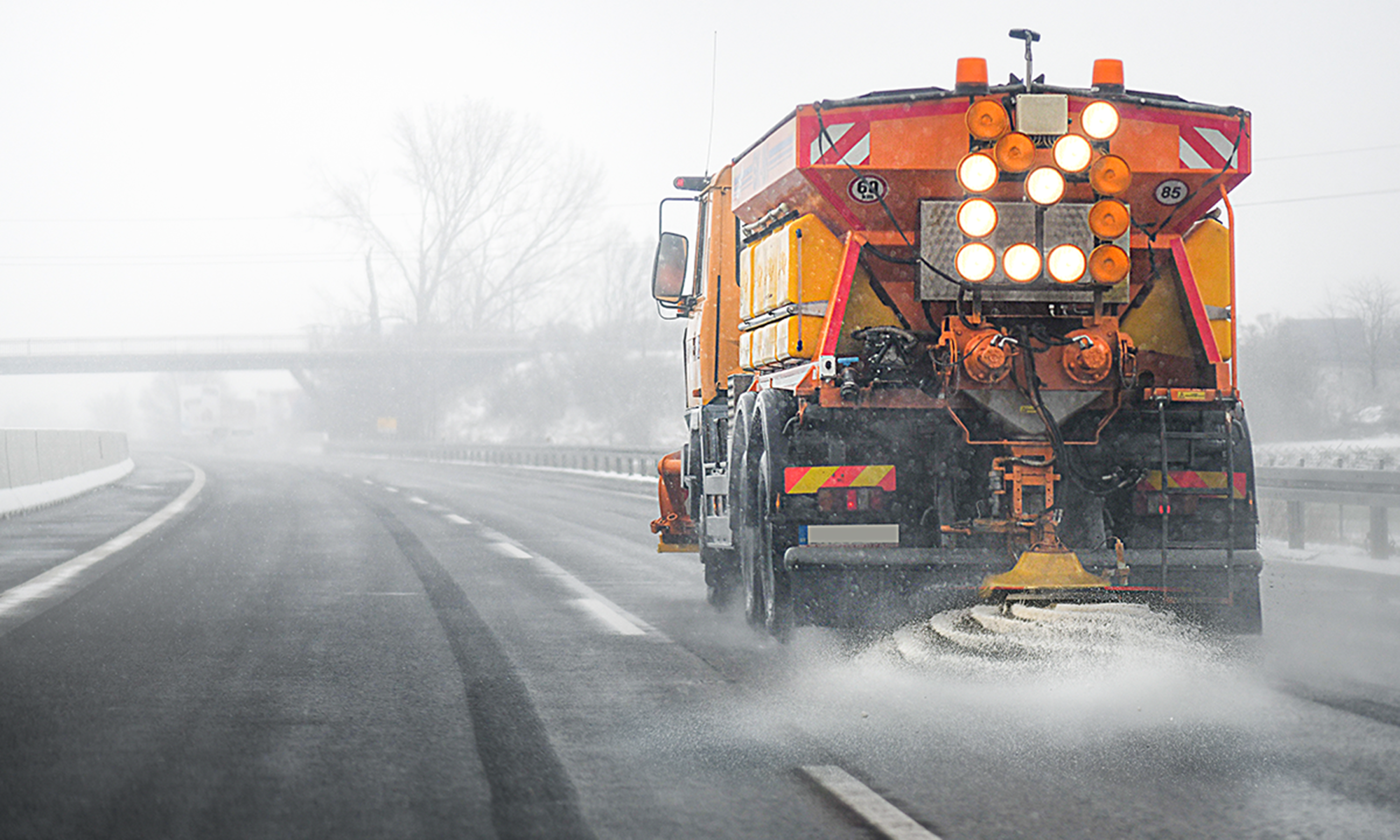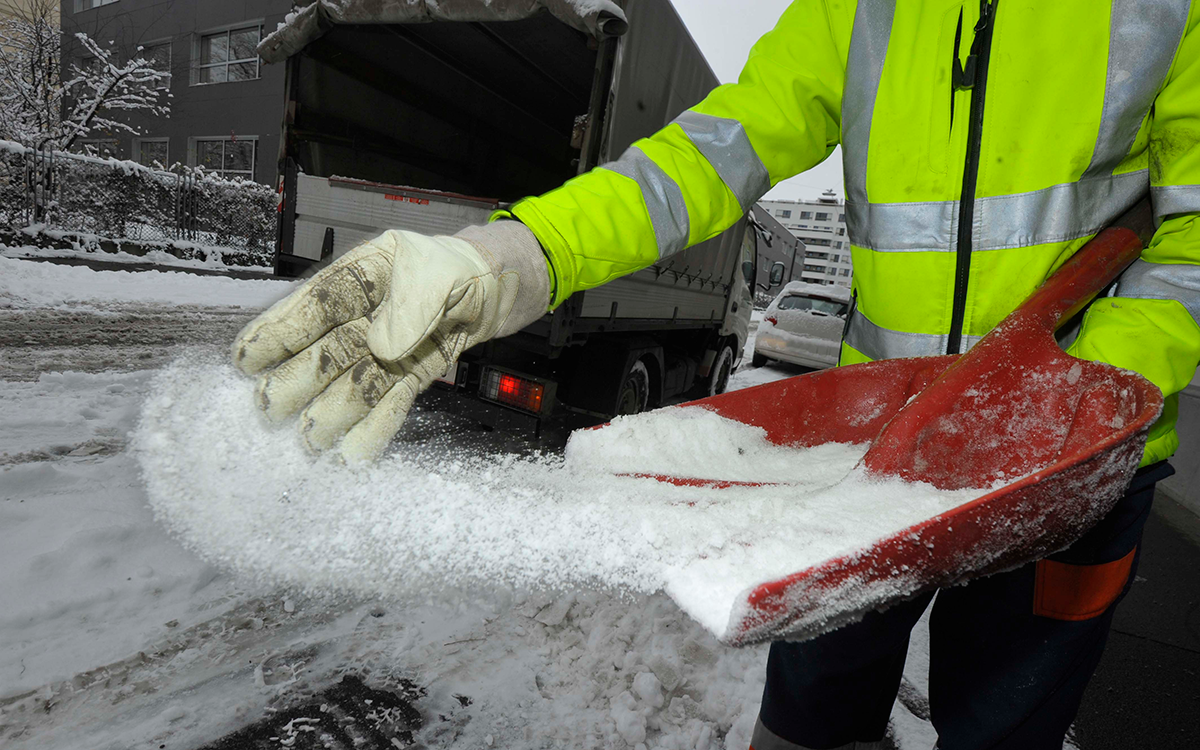The Effects of Road Salt on Your Car

Even with the holiday season and the New Year in the rearview mirror, it’s still wintertime for much of the country. And for those areas with snow still in the forecast, road salt will likely play a key role in keeping roads safe during the rest of the winter months ahead.
However, while road salt is essential for more confident winter driving, it can also harm your car. Over time, exposure to road salt can lead to rust (also known as iron oxide) and other forms of corrosion on your car’s body, undercarriage, and other systems. This can not only damage the appearance of your vehicle, but it can also affect its safety, value, and longevity.
Let’s explore what’s involved with road salt and your car.
What Is Road Salt?

Road salt, sometimes called halite, is used to melt ice and snow on roads and highways. It is applied to roads before or during a winter storm to keep the streets clear and safe for travel. Road salt is chemically identical to table salt; they’re both sodium chloride (NaCl). However, road salt is less refined than what’s used for food.
This de-icing material is usually made from rock salt, a type of salt mined from underground deposits. It is also sometimes made of other kinds of salt derived from seawater, such as solar salt or brine.
Road salt is effective at melting ice and snow because it creates a chemical reaction that reduces the freezing point of water. When salt is applied to ice or snow, it dissolves in the moisture and creates a saltwater solution. This mixture has a lower freezing temperature than plain water, so it can help to melt snow and de-ice roads, as well as help to prevent the treated areas from re-freezing, making it possible for cars to travel safely. This chemical reaction, however, is what can pose a risk to your car.
How Does Road Salt Affect Cars?
While road salt can help make winter driving conditions safer, like clearing up icy roads. However, it can significantly impact many of a vehicle’s systems. Here are some likely problems arising from road salt build-up on a car.
- Frame & Body Corrosion: The chemical reaction caused by road salt is great for cleaning up ice and snow, but it also can lead to corrosion issues, especially on the underbody of a car, where it can come into contact with the frame and other structural parts. These components are typically made of steel and are particularly susceptible to rusting when exposed to salt. Similarly, most car bodies are also made of steel, so excess road salt damages these surfaces when left untreated.
- Paint Damage: When road salt comes into contact with a car’s paint, it can cause the finish to become dull, chipped, or faded. In extreme cases, the salt can cause the paint to blister or peel off the metal surface.
- Brake Deterioration: The brake system of a car consists of several metal components, including brake pads, rotors, and calipers. When road salt comes into contact with these components, like other metal components, it can cause them to rust and become damaged over time. This can lead to reduced braking performance, which can be dangerous when driving in slippery conditions.
- Suspension Decay: A car’s suspension consists of several metal components, including the springs, shocks, and control arms. These elements are subjected to much wear and tear and are vulnerable to corrosion when exposed to road salt. If the suspension components become rusted or weakened, it can lead to reduced ride quality and handling and increased wear on other systems.
- Other Component Failures: Other components, like the engine, muffler, and electrical system, can be affected by road salt exposure. Spark plugs, ignition coils, the starter motor, the alternator, and the battery rely on metal parts to operate. A build of rust and corrosion can lead to reduced engine performance and electrical issues, such as difficulty starting the car or battery problems.
Tips for Dealing with Road Salt
Learning more about how road salt can impact your vehicle is vital for any car owner dealing with winter weather every year. However, it’s just as important to know how to deal with road salt on your car to help you avoid any possible issues during the rest of the winter or come spring.
- Wax Before Winter: Car wax is a sealant that adds an extra layer of protection for your car’s paint, shielding the surface from road salt and other destructive elements. In addition, getting a good wax coating on a vehicle has other upsides, like making the car easier to clean and less likely to accumulate winter road grime (including road salt).
- Get Regular Car Washes: Prompt removal of road salt is vital to prevent corrosion and paint damage. Depending on where you live, this may involve just going to the car wash a few days after each snowstorm or may require weekly or bi-weekly washes. Be sure to include cleaning the undercarriage on your to-do list, too, whether you’re washing the car on your own or at a professional car wash.
- Inspect for Damage: Winter weather can impact your car in many ways, regardless of whether your town or city uses road salt or not to treat roads. That’s why it’s best to regularly check your car for issues (both inside, outside and under the hood) before the spring. Early detection of potential problems like rust and failing components can prevent an expensive fix later on and ensure safe driving ahead.
- Fix Problem Areas: Get paint scrapes and exposed metal areas treated ASAP to prevent troubles from developing in the first place. Further, don’t allow any rust or corrosion to build up; these conditions won’t go away on their own and will only worsen.
- Avoid Potholes & Puddles: While avoiding potholes is good advice any time of year, these roadway defects are frequently holders of road salt pools waiting to get splashed onto your car. The same can be said for post-storm puddles once the weather starts to warm up slightly. Get in the habit of steering clear (when it’s safe) of these areas to minimize your car’s exposure to road salt.
- Stay Far Behind Snow Plows: While it can be tempting to closely follow a snow plow with the hopes of driving on a clean roadway, your car will likely encounter undiluted amounts of road salt from the truck’s backend spreader. What’s particularly bad is that the granular form of road salt can cause chips and nicks on your car’s finish, especially when being flung from the plow.
- Get a Post-Season Detailing: Getting your car detailed after winter is an excellent way to remove road salt and other paint surface build-ups and avoid any possible rust damage. This step is also another opportunity to inspect for post-winter damage.
- Consider Additional Undercoating: While most modern cars already have sufficient undercoating, an older car may need additional undercarriage protection. Existing undercoating may have deteriorated or become damaged over time. A professional should do any work to ensure new undercoating isn’t applied to a rusty surface (which would only mask a corrosion problem, not fix it). Another way to deal with ownership of any older car is with a vehicle protection plan. For example, Endurance offers numerous options that help with breakdowns and surprise repair bills for cars up to 20 years old, regardless of mileage.
Knowing how to help protect your car from road salt damage is a must for any car owner. It’s also just as important to help protect your car from those unexpected breakdowns and repairs you can’t avoid, and an Endurance auto protection plan is just the way to do it. Plus, regardless of your Endurance plan, you’ll enjoy various perks and benefits, including 24/7 roadside assistance and towing, lockout services, trip interruption coverage, and rental car reimbursements. So no matter where you are, Endurance is there to help ensure you can get back on the road as quickly as possible, regardless of the time of year.
Year-Round Protection with Endurance
Beyond dealing with road salt, there are other ways to protect your car, regardless of the season. A vehicle protection plan from Endurance can lessen the sting of breakdowns and unexpected repair bills any time of the year, including giving you coverage for as low as just $79 per month.
Plus, every Endurance plan is supported by 24/7 roadside assistance, rental car reimbursement, and trip interruption protection. You’ll even have a 30-day money-back guarantee, convenient payment options, and the freedom to take your car to any ASE Certified mechanic or repair shop, including your car’s dealership.
Best of all, along with your complimentary benefits and choice of repair shops, all new Endurance customers can enjoy a full year’s worth of FREE Elite Benefits, including extra perks and savings like tire repairs and replacements, collision discounts, key fob replacements, and even up to $1,000 in total loss protection.
Don’t get stuck paying for expensive auto repair bills; get started with an Endurance protection plan by calling our award-winning customer care team at (800) 253-8203 for a free, no-obligation quote or shop online today. Don’t forget to also check out the Endurance blog for even more expert-written articles covering everything from car maintenance tips and tricks to vehicle buying guides, make/model reviews, extended warranty coverage comparison and much more.













Larry Witherspoon Jr. is a co-founder and Executive Director of the Automotive Training Center. Larry has held multiple leadership positions in the U. S. Navy and with various Fortune 100 companies. In addition to his business experience, Larry grew up understanding the difficulties all young men face becoming adults especially those that come from challenging circumstances. He has taken those experiences growing up and combined them with his passion for vehicles to start the Automotive Training Center. Read more about Larry.